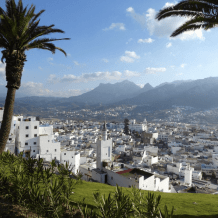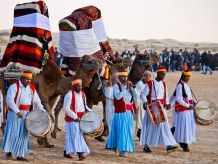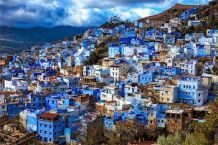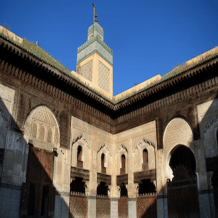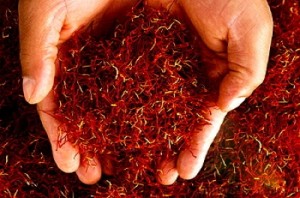
Saffron is a deep red spice that comes from the purple Saffron Crocus, or Crocus Sativus, and is found in many Moroccan food recipes, is used as a dye, and is believed to have medicinal benefits. The spice itself comes from the tiny thread stigmas of the flower which are traditionally hand-picked and then sun-dried to bring out the aromatic flavor. It takes 140 flowers to produce just one gram of saffron that accounts for its high market price, in fact, saffron has been said to be worth its weight in gold, literally!
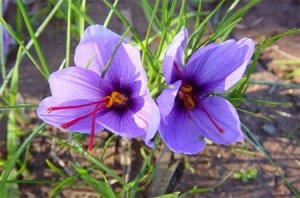
The most famous place for saffron production in Morocco is in the town of Taliouine which is located at the heart of the Sirwa Mountains between Ouarzazate and Agadir. In ancient times the women of the village would harvest the saffron, a painstaking and time consuming job, from the wild flowers that grew on the mountainside. In the 1960’s the Jews of Taliouine helped finance saffron production and today coops dominate the saffron scene in Taliouine.
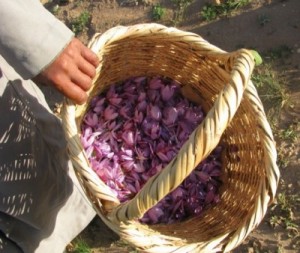
While saffron is available for purchase at any one of the souks throughout Morocco visiting a saffron coop in Taliouine is truly a worthwhile experience. Each coop offers a tour of the village, a history of saffron and the farm, and the opportunity to sample one of the most prized spices in the world. The bulbs of the flowers are planted in September and come to bloom by the end of October transforming the chalky landscape into a sea of purple and green, it truly is a sight to see.
For more information about visiting a Saffron Farm or Cooperative in Talouine and for a Morocco Cultural and Saffron Farming Tour.
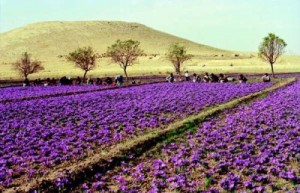
MOROCCO CULTURAL TOUR & SAFFRON FARMING IN TALIOUINE
As a result that Saffron farming primarily takes place during a 2-3 week period each year in October the following Saffron Farming Tour lists the recommended dates for travel which can be slightly altered.
DAY 1: ARRIVE IN MARRAKECH
►Morning Arrival at Marrakech’s Menara Airport.
►Relax, explore and unwind. Shop the souks of Marrakech.
►Dinner Recommendations: Djemaa El Fna Square, Al Fassia, Dar Marjana, Le Fondouk, Dar Yacout, Le Tobsil
►Spend the night at 4 Star Charming Riad in Marrakech.
DAY 2: MARRAKECH (GUIDED HISTORICAL TOUR)
►Begin your one-day Historical Tour of Marrakech.
►Your introduction to Marrakech will begin in the new city, we will navigate our way to French, Gueliz and head to the Majorelle Gardens, a magical and lush small garden estate designed by Jacque Majorelle and maintained by Yves Saint Laurent. The Majorelle Garden is filled with colorful walkways, ponds, cactus and plants as well as a beautiful shop with hand-made goods. On our return to your hotel, we will pass by the La Mammounia Hotel Garden (where Alfred Hitchcock wrote the famous film The Birds).
►Visit the 19th Centurey Bahia Palace, originally built for Si Moussa, a former slave who became King Moulay Hassan’s chamberlain. The palace holds a courtyard and riads decorated with and the most beautiful carved stucco, Arabic architecture. Next visit the 16th Century Saadian Tombs and El Mansour mosque. Marrakech is a city of underground channels built by the architects from Cordoba, Spain to provide water for the town and Palmery.
►Next visit the old, Medina, the old quarter of the Marrakech. From here we will explore this historically charming area by foot. In Djemma el Fna, you will visit the famous 12th century Koutouba Mosque, its influential minaret and gardens.
►Your guide will lead you through the labyrinth streets and alleys of the Djemma. Enjoy aromatic smells, taste fresh squeezed orange juice and venture into the souks specializing in Berber carpets, silver jewelry, artisan workshops, handmade shoes and tanneries. Enjoy a three- course lunch consisting of fresh salad, tajine and fruit at one of Marrakech most delectable restaurants.
►Next we will visit the Museum of Marrakech, a Contemporary Moroccan Art Museum or Tiskiwin, a private museum dedicated to popular arts & crafts, styled as a beautiful Spanish-Moroccan house, next door to Dar Si Said palace, a smaller version of the Bahia.
►Late afternoon, before sunset, tour the Menara Gardens. Evening free to explore Marrakech on your own.
►Dinner Recommendations: Al Fassia, Dar Marjana, Le Fondouk, Dar Yacout, Le Tobsil
►Spend the night at 4 Star Charming Riad in Marrakech.
DAY 3: MARRAKECH – TIZI-N- TEST PAST – TARODAUNT
(Driving Time: 4 Hours)
►Breakfast at our Riad. Then take the road past the Tizi-n-Test towards Taradount.
►Tizi-n-Test is a pass at 2100 meters above sea level. It is characterized by greenery juxtaposing red clay hills and roads. Tizi-n-Test is the point in the High Atlas Mountains where the many valleys of Marrakesh meet the Sahara of Morocco. Trekking in Morocco takes fortitude and knowing where the best places to visit are.
►On your trip driving through Tizi-n-Test, you will be able to see the almond trees and walnut trees in bloom. Large gardens can also be seen from significant points in the valley regions. White flowers often grow in the gardens reflecting in the sun. The scene is surreal but inviting and Utopic indeed. The road is just one way to get through the pass and around Morocco. The pass runs into the Sous Plains and then on to Ourigane and into Amizmiz. Amizmiz is one of the most beautiful villages of Morocco. At Amizmiz there is an old Kasbah. The Kasbah is slowly being eaten away by the elements, but it is still glorious to see sitting within the olive trees of the region.
►The Tizi-n-Test Pass leads to Tin Mal, which houses a Mosque still used today. The Mosque shows of the culture and history that is ripe throughout Morocco and especially the High Atlas Mountains.
►Lunch in the Pass and then Arrive in Taradount in mid- afternoon.
►Check into your Riad in Taradount. Enjoy the property’s gardens, palmary and swimming pool.
►Dinner & Spend the night at a charming 4 Star Riad in Tarodaunt.
DAY 4: TARODAUNT
►Breakfast at your Riad in Tarodaunt, then begin your one day leisurely tour of the old city that combines history with shopping and exploration.
►With its majestic gold, pink and orange tinted circuit of high walls, Taroudant is half citadel and half oasis. It is a town of great charm. The ruddy, clay houses, minarets and groves of oranges and pomegranates seem to drowse beneath the gaze of the frosted High Atlas. The walls, the Souks, and the stark backdrop of the High Atlas are the town’s main attractions.
►The Souks are not large but they are varied; there is a strong radiation of local craft and much of the works here is of upstanding quality. The beautiful walled city of Taroudant, former capital of the Saadian dynasty, is often described as a ‘scaled-down version of Marrakech’. But unlike Marrakech, almost the entire city is contained within the magnificent rich red ramparts. Lying close to the edge of the Sahara desert, Taroudant has a mainly Berber populaion who are known for their friendliness. The Berber market in Taroudant sells vegetables and spices and also clothes and household goods, while the Arab souk specializes in handicrafts such as terracotta, wrought iron, pottery, brass and copper, leather, carpets and rugs, and jewellery.
►Dinner & Spend the night at a charming 4 Star Riad in Tarodaunt.
DAY 5: TARADOUNT – TALIOUINE
(Driving Time: 1 1/2 Hours)
►Breakfast at our Riad. Then take the road to the town of Taliouine.
►Arrive in Taliouine and then visit the Saffron Cooperative to receive an overview about the varied kind of Saffron Harvest and Farming experience you will participate in during the following two days.
►En route to Taliouine there are several Saffron Cooperatives nestled within the Sirwa Mountains. The Sirwa Mountains is the traditional area of cultivation of Saffron in Morocco and has been for hundreds of years. For several years many of the Saffron cooperatives have been developing a dynamism in outreach about their Saffron Harvesting in effort to be certified by ECOCERT. They are introducing improved methods, like testing heat -draying (as in Spain and Iran).
►Lunch in Taluouine. Explore the local Kasbah and Taliouine Village.
►Dinner & Spend the night at a charming guest house in Taliouine.
DAY 6: TALIOUINE SAFFRON HARVESTING (English Speaking Guide & Harvesting Specialst All Day)
►Breakfast at the guest house, then spend the day learning about the harvesting of Saffron in Taliouine.
► The Saffron Cooperatives in Taliouine sell only biological saffron, cultivated according the traditional ways, with natural fertilizers (cow and mutton dung). The mountains dry climate is ideal for such a culture, and prevents parasites, hence pesticides and fungicides.
► Weeding is done manually, with regular ploughing that breaks the ground crust before irrigations and limits the amount of water needed. It is a plant very easy to
cultivate, apart the very intensive hard-working time of the harvest.
►Among the 1.200 agricultural hectares, 150 are dedicated to saffron, and provide a living for 1.200 people. During harvest, saffron is very demanding, and the whole families will work up to twenty hours a day, first to harvest the flowers before the sun is too high, after that, in a semi-dark room, cut the stigmas that make the spice, once dried. All this entirely by hand, and, between harvest and preparation, a gram of dry saffron requires around three hours of work!
►The cooperative centralizes the production, buying it a month after the harvest, and markets it. It also has a role of quality insurance, specially making sure that the biological norms are respected. Up to now, saffron was dried without any additional heat, when saffron from Spain, Greece or Iran is dried over stoves. But this year, a stove will be installed and used for the first time, on a small percentage of the harvest. The humidity percentage must be very low, and saffron will continue to dry in the cooperative’s storages. Storages which can be opened only by two different persons together, as they can contain a real fortune! Remember that Taliouine produces up to three tons of saffron, and that a gram costs between 10 and 30 euro per gram!
DAY 7: TALIOUINE HARVESTING CONTINUED
►Dried saffron has a beautiful deep red colour. It can be stored for months, even several years say the connoisseurs, light is its only enemy, destroying quickly its vitamins and taste.
►Dinner & Spend the night at a charming guest house in Taliouine.
DAY 8: TALIOUINE HARVESTING
(English Speaking Guide & Harvesting Specialst All Day)
►Breakfast at your guest house.
►Spend the day with your English speaking guide to continue researching and participating in harvesting Moroccan Saffron.
►Dinner & Spend the night at a charming guest house in Taliouine.
DAY 9: TALOUINE – AIT OUZZINE – AGDZ – OUARZAZATE
(Driving Time: 3 Hours)
▶Breakfast at your guest house then take the road to Ait Ouzzine.
►Aït Ouzzine is a Berber village inhabited by over 300 families who live in beautifully painted crenulated kasbahs, with their own henna fields, water wells, livestock and gardens. This peaceful village is tucked away along an impressive desert route connecting the Draa Valley (Tansikht) and Rissani.
►Meet a local Berber family, partake in a cooking lesson of how to make traditional bread and a tajine.
►Then explore and tour the village by foot. Walk in the green fields and see how the traditional Berbers live with their gardens of herbs, live stock, and henna plants.
►Lunch will be served to you in Aït Ouzzine by a traditional Berber family. The menu will include a traditional meal of fresh baked bread with spices and a chicken and vegetable tajine and fresh local fruits for desert.
►After lunch, you can have your hands and feet painted with henna or your hair adorned with saffron by a local village artist and relax. Experience the tradition of Berber perfume made from musk and amber along with the villages own spices.
►End the afternoon in Ait Ouzzine with mint tea and almonds. Take the through the Draa Valley back to Ouarzazate before sunset. The Draa Valley is the road of the old caravans that were once traveled to transport dates and other good from the Draa Region to Marrakech. Arrive and have dinner at your Riad.
►Spend the night at 4 Star Charming Riad in Ouarzazate.
DAY 10: OUARZAZATE – SKOURA – VALLEY OF ROSES (EL KELAA DES MGOUNA) BOUTHGRAR (VALLEY OF NOMADS) BOUMALNE DADES VALLEY & GORGE –
(Driving Time: 2 1/2 Hours)
►Breakfast at your Riad. Take the road to visit Bouthgrar, the Valley of Nomads and the Dades Valley.
►En route to the Valley of Nomads, visit the sleepy town of Skoura, it’s one-thousand kasbahs and extensive palmary. Visit the famous Kasbah Amerdihl and then continue the road past the Valley of Roses, towards the Valley of Nomads.
►The perfumed Valley of Roses, just north of El Kelaa Des Mgouna is a pleasant journey in route to Ouarzazate. Your driver will stop for you to view the Capp et Florale distillation factories laid out in the small kasbah town that manufacture the entire nations products of eau de rose.
►The rose water and other products such as hand and body soaps, oil, crème perfume and dried flowers are for sale and also popular among Moroccans. The factories produce 3000-4000 petals a year. With ten tons of petals required to produce a few liters of precious oil, the harvest is understandably a labor of love and the culminating festivities of the annual Rose Festival are all the livelier for it.
►Begin your visit at the breakthtaking Valley of Nomads. Located in Bouthgrar is the Valley of Nomads, a beautiful 10 kilometer valley where Nomads live in caves that are surrounded by Mount Mgoun. Mount Mgoun is the second highest mountain in Morocco and boasts extraordinery views. Have tea with a Nomad family. See first hand where they make their own carpets and co exist in Bouthgrar with other Nomad families.
►Your journey will then take you through the Dadès Valley which covers 125 km between Ouarzazate and Boumalne du Dadès in the High Atlas Mountains.
►Once you reach Boumalne at first sight you notice the limestone cliffs with uniquely shaped erosions and superb scenery and the valley’s pise (windy roads). Driving along you will pass flower filled fields, fertile fields, riverbanks and several fortified ksours. At the bottom of Gorge of Boumalne Dadès there are ruined hilltop Kasbahs and valley floor gardens.
►Lunch will be served at a nearby guesthouse that offers local Moroccan fare and a panoramic view. Relax and sip mint tea while gazing at the impressive valley view.
►Spend the night at 4 Star Charming Riad in Ouarzazate.
DAY 11: OUARZAZATE – OASIS OF FINT – AIT BEN HADDOU MARRAKECH – KASBAH TELOUET
►Breakfast at your Riad.
►Take the windy road by piste visit the Oasis of Fint passing the “Plateau de pierres”. Journey on a one-hour walk inside the Oasis where you will have a cup of tea with the headmasters family Azziz Ouaziz and tour the surrounding area where date palm oases and dramatic desert scenery are king.
►“See Ouarzazate and die” are feelings often expressed by Moroccans with regards to this magical city that is the door to the Sahara desert. Located just four hours from Marrakech, Ouarzazate is the main Berber city in the south known for its spectacular sunsets and dramatic mountain and desert scenery. Surrounded by breathtaking valleys, Ouarzazate was once crossing point for African traders seeking to reach northern cities in Morocco and Europe. During the French period, Ouarzazate expanded considerably as a garrison town and became the administrative centre of the Zagora region. Ouarzazate became famous when it’s nearby Kasbah; Aït Benhaddou appeared in the 1962 film Lawrence of Arabia.
► Visit Ait Benhaddou. Located 32 km from Ouarzazate lies the picturesque village. Aït Benhaddou of Aït Benhaddou is situated in Souss-Massa-Draâ on a hill along the Ouarzazate River. Lawrence of Arabia was filmed here and Orson Welles used it as a location for Sodome and Gomorrah; and for Jesus of Nazareth the whole lower part of the village was rebuilt. In recent years more controlled restoration has been carried out under UNESCO auspices. Aït Benhaddou is one of many locations in this region used for shooting Hollywood films. Aït Benhaddou which once served as the former caravan route between the Sahara and Marrakech in present-day Morocco. Most of the town’s inhabitants now live in a more modern village at the other side of the river; ten families however still live within the ksar.
►Your guide will lead you on a private tour through this Berber village of towered and crenulated Kasbahs that once guarded the lucrative caravan route through the Atlas Mountains. Explore the Kasbahs by foot with the option to ride a donkey across a river. Aït Benhaddou which once served as the former caravan route between the Sahara and Marrakech in present-day Morocco. Aït Benhaddou was once a significant stop for traders carrying gold, salt and slaves along the famous Southern Caravan route moving through the Sahara.
►Dinner & Spend the night at 4 Star Charming Riad in Ouarzazate.
DAY 12: OUARZAZATE – MARRAKECH
(Driving Time: 4 1/2 Hours)
►Breakfast at your Riad, then take the road to Marrakech.
►During your journey to Marrakech you will pass the olive groves of the Oued Zat, as you ascend onto the Tizi-N-Tichka Pass Road. Built by the French in the 1920’s, the Tizi-N-Tichka Pass can be described as having mountainous barriers, Mediterranean and oceanic influences and desert borders. long the route you will see panoramic views of the High Atlas Mountains as well as sights of fertile valleys, blue and red colored pise villages and other striking mineral environments.
▶En route you will go by piste to visit Kasbah Telout, one of Morocco’s hidden jewels and a famous Kasbahs that is the origin of the Pacha Glaoui Family. Kasbah Telout is hidden among a tiny road in a small village that is 20 minutes outside Tichka. It’s history stands alone with its original zellij tile, authentic, preserved silks and grand remnants of the Glaou family. Unlike the other Kasbahs in Southern Morocco, Telout was occupied by the Glaoui’s instead of the slaves and has stunning views. This Kasbahs has yet to be coined a UNESCO World Heritage site and while it appears in parts to be in ruins on the exterior, its interior is one of true splendor.
►Lunch in the village of Tadart and visit the Argan Cooperative where Argan Oil, Butter and Cosmetics are made with the Argan nut by hand as Berber women crack the nuts and the grind them one by one. Have a complimentary tasting. This cooperative is run entirely by women. Lunch in the village of Tadart.
►Dinner Recommendations: Le Marrakechi, Le Maison Arabe or Le Comptoir. Explore Marrakech’s Djemma El Fna Square.
►Dinner & Spend the night at 4 Star Charming Riad in Marrakech.
DAY 13th: MARRAKECH DEPARTURE
►Breakfast at your Riad.
►Departure from Marrakech’s Menara Airport
For more information about Saffron Harvesting or a Moroccan Saffron Tour
For more information about Travel and Tours to Morocco plus highlights on Moroccan culture visit Morocco’s Imperial Cities, Seaside Resorts,Sahara Desert, Berber villages, A Taste of Morocco, Magical Kasbahs, Ruins & Waterfalls, Absolute Morocco, The Best of Marrakech, Fes, and Ouarzazate
 Travel Exploration specializes in Morocco Travel.We provide Tours and travel opportunities to Morocco for the independent traveler and tailor-made tours for families and groups with a distinctly unique flavor. From Morocco’s Seven Imperial Cities, to the Magical Sahara Travel Exploration offers a captivating experience that will inspire you. At Travel Exploration we guarantee that you will discover the best of Morocco! Call Travel Exploration at 1 (800) 787-8806 or 1 (917)703-2078 and let’s book a tour to Morocco for you today.
Travel Exploration specializes in Morocco Travel.We provide Tours and travel opportunities to Morocco for the independent traveler and tailor-made tours for families and groups with a distinctly unique flavor. From Morocco’s Seven Imperial Cities, to the Magical Sahara Travel Exploration offers a captivating experience that will inspire you. At Travel Exploration we guarantee that you will discover the best of Morocco! Call Travel Exploration at 1 (800) 787-8806 or 1 (917)703-2078 and let’s book a tour to Morocco for you today.
Moroccan Saffron Harvesting, Moroccan Saffron, Saffron, Saffron Crocus, Morocco Saffron Tour, Talouine, captial of Saffron in Morocco, Sirwa Mountains, Ouarzazate, Tizin Test Pass, Morocco Holidays, Morocco Travel, Travel Exploration, Travel to Morocco

